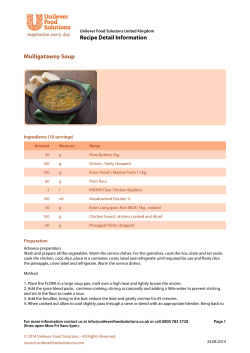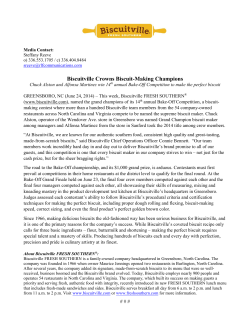
Fare Report: Monkey Bread B5
The Exponent Wednesday, Sept. 18, 2013 Telegram B5 Fare Report: Monkey Bread There are certain times of the year that elicit childhood memories. The temperature, the breeze, the changing leaves or a rainbow after a storm all usher in nostalgias from a different time. September in particular reminds me of one of my childhood friends. Well, her birthday party to be exact. Every year, Steph would invite a gaggle of little girls to her home for a slumber party. And every year, her mom would make Monkey Rachel Jarvis Columnist Bread for breakfast. The usual cast of invitees would wait excitedly for the day to arrive. We would make sure to ask whether Monkey Bread would make an appearance. It always did. In the mornings, we would stand around in her mom’s kitchen waiting for it to come out of the oven, and once it did, squeals from little girls could be heard around the neighborhood. Monkey bread is a sugary treat so I wouldn’t recommend it as a regular breakfast staple, but it is perfect for an indulgent birthday breakfast snack. Serve with blueberries, halved strawberries, milk and juice for a truly scrumptious breakfast experience. Monkey Bread 4 tubes of refrigerated biscuits 1/2 cup sugar 2 teaspoons ground cinnamon 1/2 cup butter, melted 1/2 cup packed brown sugar Pre-heat oven to 350 degrees. Cut each biscuit into four pieces. Shape pieces into balls. Combine sugar and cinnamon in a small mixing bowl. Roll the biscuit balls in the sugar and cinnamon mixture. Arrange biscuit balls evenly in a greased 10-inch fluted pan. Sprinkle biscuit balls with the remaining sugar and cinnamon mixture. Combine melted butter and brown sugar in a small mixing bowl. Then, pour the melted butter and brown sugar mixture over the biscuit balls and bake for 35 minutes. Serve warm with berries, milk and juice. Enjoy! Competition to enhance your next meal by Brian A. Floyd, CEC, CCE PIERPONT COMMUNITY & TECHNICAL COLLEGE Imagine having to prepare and serve a four course meal f r o m scratch in 75 minutes. In addition, imagine the pressure of having masFloyd ter chefs looking over your shoulder as you fabricate a whole fish or whole chicken. Consider having to perform exact knife cuts on vegetables that are measured for precise accuracy. September brings culinary team tryouts for our students. Believe it or not, the requirements above are the exact expectations for the students that make the team. Competition necessitates efficiency, and often spurs innovation. The average person at home, of course, probably doesn’t enter judged culinary competitions. However, most of the food industry trends can be traced to national and international competitions. National restaurant chains are a common area where competition innovation often can be identified. The flavor combinations that you see on new menu selections frequently were at one time developed as part of a competition menu. Another area of the food service industry that has benefited from competition is food safety and sanitation. The standards for competition insure that the integrity of food and the practices of the competitor are impeccable. The American Culinary F e d e r a t i o n (http://www.acfchefs.org/) is recognized globally as one of the preeminent organizations for chefs. The federation supports and sponsors the United States Culinary Olympic team, and helps to establish competition guidelines. Competitors at this level compete on an international stage. Interestingly, our culinary students are judged by the same standards. In fact, in some cases, they are judged by the same judges. At the junior hot foods competition, the four team members and alternate participate in three separate phases of competition. They begin with an 80minute skills relay. One fabricates (or butchers in a very specific way) a chicken, one member fabricates a fish, one member performs intricate vegetable cuts, and finally, one of the team prepares a list of pastry skills. Next, the team has 75 minutes to prepare a four course meal for four people. The menu includes an appetizer, salad, entrée and dessert. Either the appetizer or entrée has to be prepared Submitted photos Top, desserts in culinary competitions tend to rely not only on taste, but artistic presentation. Above, this salade Andalouse is an example of a visually appealing dish. using a very specific classic recipe. Generally speaking, each course may have four to 10 different recipes. Lastly, the team prepares a platter for eight people. The food for the platter is not tasted, but rather designed for artistic presentation. A number of variables and guidelines has to be considered when producing the platter, but the end result usually is some of the most visually appealing, beautiful food that you will ever see. The proliferation of the Food Network has introduced the American public to many cooking competitions. The raised consciousness helps us to appreciate unique ingredients and helps to educate dining consumers. The next time you go out for a fine meal, realize that the wonderful flavor combination or the artful presentation may have been first tested on a master chef. Brian Floyd is the executive director of the Pierpont Culinary Academy and dean for the School of Human Services at Pierpont Community & Technical College. Chicken with a kick Editor’s Note: Readers who would like to submit recipes and the stories behind them should email them to news@exponent-telegram.com or call (304) 6261448. by Neelam Worth LEWIS COUNTY This dish is so popular in North India that many households (including ours) cook it on weekends for the family. It’s a little spicy for an American, but my husband, who’s American, can’t get enough of it. He loves it, and I am sure you will, too! If you are fond of spicy food, then try this dish cooked with an abundance of tomatoes. Serve with Basmati rice, flat Indian bread and yogurt sauce called Raita (recipe follows). Home-style North Indian Chicken (curry) 2-3 whole chicken breasts, skinned, boned and cut to bite-size pieces 3-4 tablespoons of canola oil (can add more if needed) 1 1/2-pound ripe tomatoes, chopped fine 1 1/2 cup or one big onion, chopped fine 2 teaspoons chopped garlic 2 teaspoons chopped fresh ginger 2 tablespoons of tomato puree 1/4 cup chopped fresh cilantro 1/2 teaspoon chili (red) powder 1/4 teaspoon turmeric powder 1 to 3 hot fresh green chilies Grind to make powder of the following (called “garam masala,” meaning hot spices): 1/4 teaspoon cinnamon, 1/4 teaspoon black pepper, 2-3 cloves, 1/4 teaspoon cumin (seeds or powder form). Heat oil in a large cooking saucepan. Add chopped garlic and chopped ginger until light brown, then add chopped onion, sauté until golden brown, then add the chopped tomatoes and tomato puree. Sauté this mixture for 5 to 7 minutes until it’s thick and brown. Now add the chicken pieces to this, along with the turmeric powder and child powder. Keep sautéing until chicken is tender and golden brown. You will notice that nothing sticks to the pan and the oils come out. This is a sign to taste the chicken, making sure it is fully cooked. Add salt to taste. Now, add 1 1/2 cups of water. Let it come to a boil and thicken a little (this is called chicken curry, or sauce). Add finely cut up hot, fresh green chilies. Finally, add the garam masala (which was powdered earlier with dry spices) and stir for 1 to 2 minutes. Chicken curry should now be tender and ready to eat. Garnish with chopped cilantro leaves. Raita 1 tablespoon chopped fresh mint or cilantro for garnish 2 1/2 cups plain yogurt 1 small cucumber, peeled and seeded 1 small onion, minced or chopped fine Salt and cumin powder to taste Slice the cumber into 1/2 inch lengths. Place in bowl with onion and yogurt. Stir to mix until creamy. Add salt and cumin powder.
© Copyright 2025





















